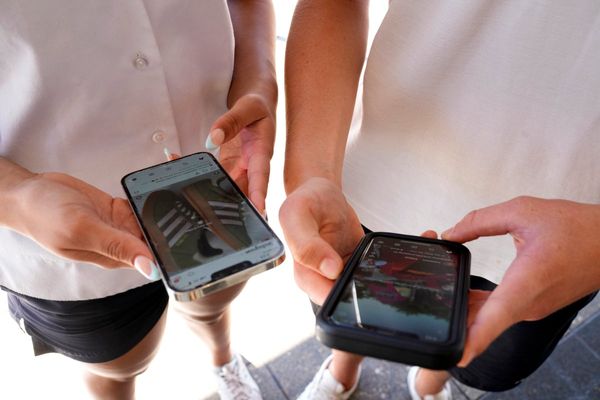
Guadalupe Plata was raising her youngest daughter while she worked two stressful, physically taxing jobs as a housekeeper and a factory worker.
After one of those intense work days, she said she felt dizzy, nauseated and light-headed. Her breathing felt shallow and rapid, and she felt a bit flushed.
Plata rushed to the doctor. The doctor put a nitroglycerin tablet under her tongue, and she had to lie down for 30 minutes.
The issue? She had high blood pressure — called the “silent killer” — because most people have no symptoms until after they’ve developed hypertension over time.
February is American Heart Month, a good time for all people to discuss heart and overall cardiovascular health, with their doctors.
Doctors say they hear patients dismiss blood-pressure readings as just so many mysterious numbers. But the reading reflects how effectively your most vital organ — your heart — is pumping to move blood throughout your circulatory system.
In 2019, more than half a million deaths in the United States had hypertension as a primary or contributing cause, according to the federal Centers for Disease Control and Prevention.
The top number, called the systolic blood pressure reading, measures the force your heart exerts to push blood against your artery walls to produce blood flow. The bottom number, the diastolic reading, measures the force the heart exerts between beats.
The ideal reading, on average, is 120 over 80, according to the Joint National Committee on Prevention, Detection, Evaluation, and Treatment of High Blood Pressure, a division of the U.S. Department of Health and Human Services.
/cdn.vox-cdn.com/uploads/chorus_asset/file/23212902/IMG_1790.jpeg)
For people 60 and older — age is a risk factor — a reading higher than 150 over 90 is considered hypertension. For anyone younger, 140 over 90 qualifies as high blood pressure.
Dr. Victor Munoz, a Logan Square native who practices family medicine and is an assistant professor at Loyola University Medical System, said people who say they feel fine fail to realize that high blood pressure, if left uncontrolled, can harm your kidneys, cause congestive heart failure, and if constant over time, can cause a stroke.
Nausea, fatigue, a headache and ringing in the ears can indicate a hypertension emergency with a blood-pressure reading of 180 over 110 or higher, Munoz said. A reading of 190 over 100 accompanied by a headache or chest pain can mean the person has suffered heart or kidney damage and is at risk for a stroke.
Plata’s highest blood-pressure reading reached 180 over 90. The mother of four started taking prescription medicine to keep her blood pressure under control and decided she had to change her lifestyle. She eventually retired from her jobs, increased her exercise — (with the help of Nova, her Chihuahua— and switched her diet by eating less red meat and more healthful, plant-based foods.
“You’re going to have to change some habits, but the change in diet and exercising more, reducing stress, those changes outweigh any negative things,” said Plata, 69, of Elmwood Park.
“People who get stressed out or upset easily need to change,” she said.
/cdn.vox-cdn.com/uploads/chorus_asset/file/23212929/PRESSURE_XXXX22_01.jpeg)
Besides getting angry and emotional, blood pressure can jump when you smoke, drink caffeine in soda, tea or coffee, and eat lots of salty and processed foods.
Munoz recommends people test their blood pressure once a month, either at a drugstore blood pressure testing station — usually a chair where you place your arm into a measuring cuff that extends from your elbow to your shoulder — or take your reading at home with a blood pressure cuff. Sit first for 10 minutes, and don’t smoke, drink alcohol or exercise strenuously for an hour before you take the measurement.
You might get a more accurate reading at home because that’s where you tend to be most relaxed, Munoz said.
“Keep a blood pressure-reading log,” he said, especially if you get stressed when you go to the doctor.
And get a yearly medical checkup.
If your result is low blood pressure — 90 over 60 or lower — that’s a danger sign, too, Munoz said. It’s a signal of an underlying and perhaps serious problem such as heart failure or an infection, so make a doctor’s appointment ASAP.
/cdn.vox-cdn.com/uploads/chorus_asset/file/23214225/AdobeStock_84947550.jpeg)
That’s easier said than done for Blacks and Latinx people, who may be distrustful of doctors because of negative healthcare experiences in the past and who may lack easy access to a clinic or doctor’s office. For Hispanics, a language barrier can also create problems.
Nearly half — 49.3% — of Black American adults in a random nationwide survey had blood pressure that was uncontrolled — that’s 140 over 90 or higher — compared with 36.6% of Mexican Americans and 35.7% of whites. The National Health and Nutrition Examination, a program of the National Center for Health Statistics, conducted the survey.
A separate survey of congregants at seven churches on the West Side revealed a similar outcome, with 51.1% of those who participated in a health screening having high blood pressure.
The underlying reasons for the blood pressure outcomes range from systemic racism and the resulting stress, to distrust of the medical profession, to cultural rituals around processed and unhealthy foods, said Elizabeth Lynch, a Rush University Medical Center researcher who is working to stem health disparities on the West Side.
Lynch is working with the West Side churches in the Allied Faith Network, where Black pastors lead Bible study connecting faith with health and promoting fresh foods and taking prescribed medicine on schedule.
In Chicago, 47.1% of Black residents said they’d been diagnosed with high blood pressure, 26.8% for Asian/Pacific Islanders, 26.6% of whites and 26% of Latinx residents, according to the most recent Chicago Health Atlas data, collected from 2014 to 2020. One-third of Chicagoans surveyed have high blood pressure, the data showed.
NOTE: The CDC has a complete guide to heart health, information and resources on its website at https://www.cdc.gov/heartdisease/american_heart_month.htm/







